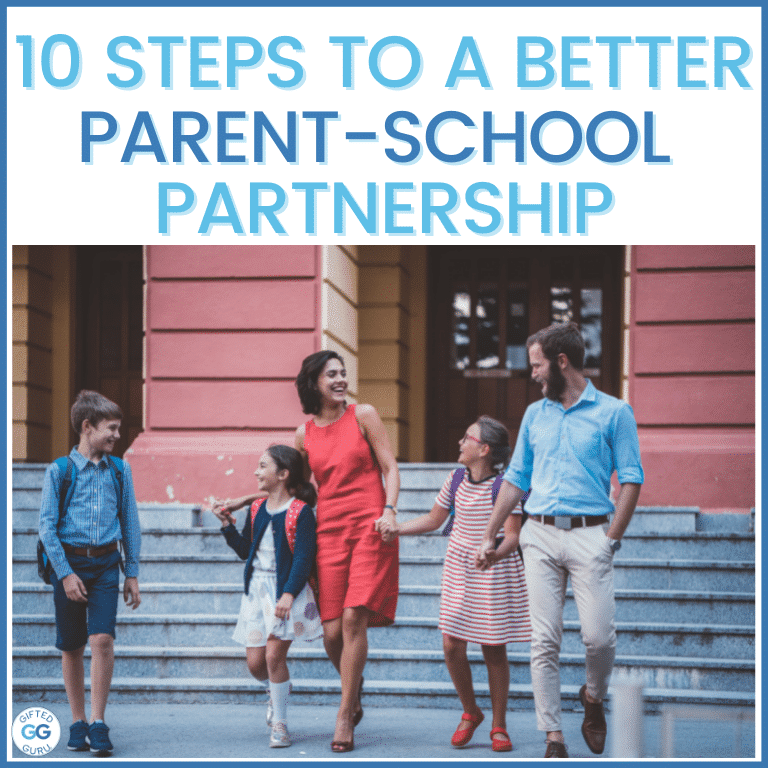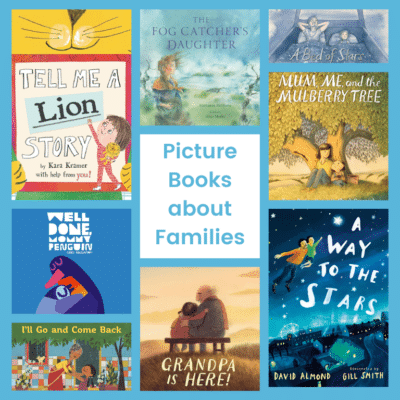Would you like to build a stronger partnership with your child’s school? If you’re an educator, would you like to consider how to build a stronger partnership with families?
When I keynoted the Colorado Association for the Gifted and Talented Conference in Loveland, I attended a session by Lisa Girard with this title. It was packed with so much great information that I asked her if she’d be willing to write it up in a form that could be shared.
Lisa graciously agreed, and the result is this article. So here are 10 tips to a better school partnership that focus on pre-action instead of re-action.
Introduction
As I’m writing this, the holidays are here – that time of year that family gathers to reconnect and remember, parents stress over the perfect gift and how to pay for it and when we parents are going to find time to make the cookies, attend the school parties, wrap the presents and send the cards. And all the while we are supposed to pause and be grateful for what we have, our relationships, our families, our opportunities, and so on.
But as a parent of a gifted/2e child, the opportunity to pause seems to never come. Intensities, struggles, challenges, that “square peg in a round hole” situation, seem to always be present, and pressing as we constantly keep watch over our child’s academic, social, and emotional path into adulthood.
Perhaps you are finding yourself again watch-dogging the school situation and hoping for a better year to come. All we want for Christmas is a school or teacher that “gets it.” We want a better school partnership.
Well, good news parents, this gift is possible, but – it is not attainable with a simple hope-and-a-prayer and a letter to Santa.
A successful partnership between your child’s school, staff, and administrators takes a shift in perspective – a shift away from fear, negative stigma, labels, and traditional thinking. Shifting your lenses way from reaction to pre-action can result in an amazingly positive outcome for both sides of the table.
So as we roll into the new year – consider these 10 tips for pre-action that will set you and your child’s school on the same path by collaborating and problem solving and opening doors for your child’s future success.
I. Keep Humanity in Mind
We are all human here. “We” are parents. “We” are teachers. “We” are principals. “We” are counselors… and we all have emotions, lives, families, jobs, and daily stress. We are all having a human experience. No one in this relationship is super-human.
Keep this in mind and proceed forward with kindness, caution, respect, and civility.
If you’re hot on a situation that is boiling – take a moment, a breath, or a few – before firing that shot across the bow in that accusatory email. Think about the situation from their perspective as well. Be prepared for what they might say in response.
II. Begin Within
This is not a “you vs. them” thing – this is a partnership. Be aware of your own triggers. Dig deep to examine what exactly is bothering you about the situation. Is it a ‘you thing’ or a truly a ‘child thing’?
For example, if your child is struggling academically, and you never struggled academically, then you as a parent will most likely have a hard time finding that frame of reference or that shared experience. Academic struggles could represent failure to you, making you feel like a failing parent, or that you made a bad choice putting your child in this school that is failing your student.
The lens shift to ‘begin within’ starts with:
- Being curious – ask questions, research, take the other’s perspective, play devil’s advocate, ask, “What if?”
- Seek connection over correction with your child, teacher, staff, and team. And in case ‘connection’ feels fuzzy to you, in a confusing kind of way, not in a warm-blanket-by-the-fireplace-kind-of-way,connection is the energy of feeling seen and heard and knowing that you matter.
This shift is hard and you will find ways to doubt it and not do it. This often comes in the form of “I don’t have time! I need answers now” … or “no, this isn’t about me, it’s about the school/child.”
Here are a few tips to get past these doubting voices.
- Ask yourself, “Is there a fear here?” Keep breaking down the fear parts into smaller and smaller pieces, until you can’t break down any more.
- Consider, what kinds of things *do* you make time for? Why is that important? What are your priorities here? What do you value? Are you thinking long-term or short-term?
III. Adjust Your Expectations
This is what author Debbie Reberrefers to as “drop the shoulds.” It is so easy to get caught up in the “he should know this by now” when our neurodiverse kids are in a neurotypical world built around a framework and rubric of milestones, time lines, bench marks and other developmental markers.
As parents of neurodiverse kids, we are constantly adjusting our expectations. We have to be flexible. This applies to expectations of our child and expectations of the school, the team, the staff, and maybe even the school district.
Same goes for when you are meeting with schools and staff. Here are some tips:
- Be flexible – realize that not all your needs will be met
- Take a list of non-negotiables
- Go into your meetings with “what you can live with” and “what you can’t live without”
- Think ahead before the meeting of “what if” – what happens if your child’s needs can’t be or are not being met? What are your options?
IV. Know Strengths and Challenges
Get to know your child’s strengths and challenges and your own strengths and challenges. Make an inventory of these and keep it handy and current.
For your child, make a resume, a video, an art piece. Have them use their passion to tell the story of their strengths.
Plan and problem solve on how to capitalize on those strengths.
Use strength-based language in your meetings. For example, “Since my son has strong problem-solving skills, he wanted to know if he could bring his balance board to class because standing on it helps him stay focused on the task.”
Use these strengths to solve the weakness problems. Lots of experts are starting to move in the direction of a strengths-based approach to problem solving. UC Berkley’s Greater Good magazine recently published this article, How to Help Students with Learning Disabilities Focus on their Strengths.
If you don’t know where to start with finding strengths – start with the 12 executive functions.
V. Accountability
Be accountable and hold them accountable. Remember to be kind and courteous (remember Keep Humanity in Mind). Don’t come barking in and then disappear.
Write down and document what they say.
Regularly check in on progress, being mindful of their time, too.
Tell the school team when you expect answers and when you plan to revisit the previous conversation action points.
Be respectful in your tone.
Ask how you can help and offer solutions.
Don’t demand, ask… remember you can kill more flies with honey than vinegar.
VI. Speak Up
If something doesn’t jive – then speak up. Ask questions, and express your discontent respectfully.
Be open-minded and open-hearted to their response. Go back to your resume/inventory as to why something they suggest doesn’t work and offer what does work.
Be vulnerable and share your story. Find your voice.
Don’t drown in the details; stay kid-centered. There will be a time and a place for details like test scores, individual testing, diagnoses/labels. School teams operate at top-level. Remember, they are not the experts in your label and they have hundreds of kids to manage. The label will help, but don’t focus on the label, especially its known short-comings. Stay top level and what you can do *now* to problem solve.
Stay present, not rooted in fear or worry of what the label experts, doctors (including Dr. Google), test scores, and other parents have been ‘feeding’ you.
VII. Involve your Child
If and when it is appropriate, have your children tell their own story. Let them expand on their passions, dreams, and struggles.
Work with your child to build a resume, make a video, write a story or poem, or do some art that features strengths, passions, dreams, and/or challenges.
Find a way to let the children tell their story.
VIII. Find a Partner
There’s a lot to be said in that popular phrase, “find your tribe.”
In finding a common thread with another peer, we find strength, support, relief, hope, and a shared vulnerability.
Some sources of support to consider are:
- teachers
- GT resource/resource teacher
- another parent
- administrator/staff member
- Facebook/online communities
- therapist/counselor/psychologist
- hired advocate
- local/regional affiliate organization of NAGC
Having the courage to share your story – and be all in – takes vulnerability. Vulnerability is that is often viewed negatively in our society. It’s seen with overtones of weakness, defeat, and fear. Step out of the fear and in to the current present moment, and you will find a strength you never knew you had buried beneath that shield of vulnerability.
IX. Do your homework
Doing your homework means talking the talk and walking the walk.
Be Prepared
Know what works for your kid. Be explicitly clear. Be prepared for the typical responses and feedback and know how to respond. Practice so you won’t be blind-sided.
Think ahead of their “yes, but” and have your response ready to go. In your response, if you are positing advice, and have resources to back it up, frame the advice as coming from other professionals and experts.
For example, if you are dealing with a 2e student who is gifted with ADHD, when addressing the issues of ADHD with your school team, bring ‘advice’ to the discussion in the form of the well-known experts in the field like Ned Hallowell and Russell Barkley, or from sources like Additudemag.
Know the laws
Get familiar with:
- IDEA – Individuals with Disabilities Education Act
- ESSA – Every Student Succeeds Act
- Section 504 – “free appropriate public education” (FAPE)
Also research your state’s laws in regards to gifted education and services.
Get involved
Find (or start) a local support group or advocacy group for gifted kids. NAGC state affiliates usually have local/regional affiliates that are parent advocacy groups and should have local resources, and ‘tribe members’ to get to know. Facebook has several gifted friendly groups to consider joining as well.
Know the school district stance, policies, state requirements.
Educate as well as advocate and educate. It is likely that your team is not aware of giftedness and/or the intricate ironies and delicate waters of GT/2e like you are.
X. Plan B It
If you are not already familiar with Ross Greene’s Collaborative Proactive Solutions “CPS” or PLAN B you can learn more about this approach to difficult situations here: for parentsfor educators
This collaborative problem-solving approach is based on the premise that “challenging behavior occurs when the expectations being placed on a child exceed the child’s capacity to respond adaptively, and that some children are lacking the skills to handle certain demands and expectations.”
Although the strategy is geared towards learning skills for challenging child behaviors, it works great with other adults as well.
The approach breaks down into these 3 I’s: Inquire, Interest, and Initiate
- Ask what’s up – Inquire, be curious
- State your Interest and concern
- Initiate a compromise
When working with your school team – try the Plan B approach. Don’t be surprised if you might have to Plan B your Plan B. Be consistent, present, open-hearted and you will probably get results. Learn more at livesinthebalance.org.
Conclusion: A Recipe for Success
A good recipe to consider for successful relationships, in both the parent-child relationship and the parent-child-school relationship, comes down to these 3 main ingredients – the 3 Cs:
Consciousness – Be aware of your triggers and your child’s triggers. Know your strengths and weaknesses and your child’s as well. Know your boundaries and your voice. Be aware of what works and doesn’t work for your child and her passions.
Compassion – Keep humanity in mind. Be mindful of what the other person is experiencing – try walking in their shoes. Consider things like “is your middle school new to accepting 6th graders? What are the top-down directives either from the principal or the district?”
Consistency– Be consistent in your goals, timeline, voice, and stance. If you need to change course, communicate that clearly. A partnership needs water – it is not a set-it-and-forget-it situation.
Meeting with school teams to discuss your child’s issues is never an easy task, and to 2e/GT families, this can feel like a Sisyphean task. It is daunting to keep pushing the rock up the hill, so hopefully, considering these tips will make the task more meaningful, manageable, and productive – ultimately setting your child on that path to success.
Wrapping Up:
This is Lisa again. I loved (the other) Lisa’s ideas here.
Developing a better school partnership is critical in meeting the needs of all children, and I loved the encouragement to preparation and empowerment through real knowledge. The emphasis here is on the strength that comes through knowing what’s real, and not just focusing on what we wish were true.
If you liked this article, there are a few others I think you would enjoy:
- Trying to Make School Better for Gifted Kids
- 3 Doubts Parents Have about Raising Gifted Kids
- The 2e Struggle: Reader Q & A
- 6 Steps to Take When School Isn’t Meeting the Needs of Your
One of Lisa’s suggestions was to connect, and one way to do that is to join with this community. I send out regular emails with suggestions and resources for parents and teachers. If you’re not already connected, please sign up and receive a free guide for helping gifted children thrive in school.
Thanks to Lisa Girard for this great article with lots of things to think about and lots of paths to consider.






